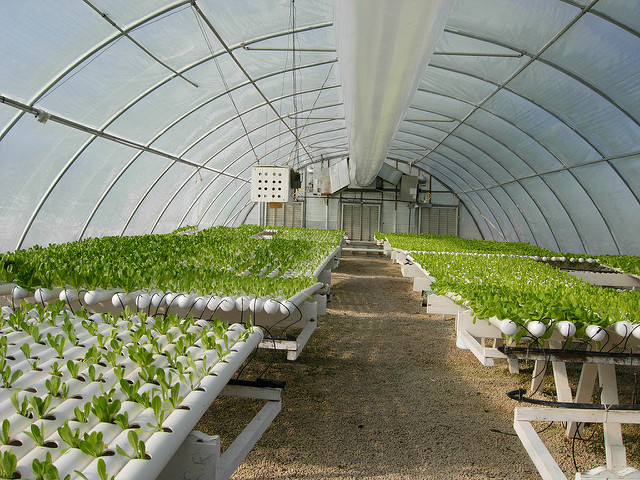Nutrient Film Technique, continued
This is page 2 of our twelve page series on nutrient film technique. Click any of the below pages to jump to that page.
Page 1 Page 2 Page 3 Page 4 Page 5 Page 6 Page 7 Page 8 Page 9 Page 10 Page 11 Page 12

Mixed ages of lettuce in a rotational NFT system. Note that the channels are grouped by age, with work space between groups.
Nutrient Film Technique Advantages
Nutrient film technique has grown in popularity because of several major advantages.
First and foremost is the micro-climate created by the thin film of nutrient solution, washing over the roots in the channel. While at first glance it would seem that the roots would suffer from drowning, the thin film actually helps ensure that the roots always have access to both water and air. This high humidity environment avoids the extremes of either drowning the roots or allowing them to dry out.
Secondly, this excellent access helps
eliminate three of the most common bottlenecks in horticulture, namely
insufficient nutrients, water and/or air.
The ready supply of all three helps optimize plant production. One of hydroponics’ claims to fame is the
boosted production possible from an optimized environment, and this is a good
example of such optimization. The only other hydroponic system that approaches this ideal mix of nutrients, air and water is the flood and drain system, albeit via a different mechanism.
Third, the plants are easy to move in and out of the system thanks to the fact that they are originally rooted into individual rockwool cubes and/or net pots. Rockwool cubes do have a certain amount of resiliency when moved from one location to the next, as long as the plant isn't rooted too deeply in some other growing medium. The net pots are even easier to move, but also have a limit in terms of how thoroughly they might already be rooted in other growing media.
Fourth, plants already growing in an NFT system can potentially be moved out of the NFT system and into another growing system. While it's technically possible to transplant from NFT into soil-based systems, anecdotal evidence seems to indicate that plants raised in any hydroponic system should stay in hydroponic systems in general. The reverse is true for plants raised in soil-based system; they should stay in soil-based systems.
Even when moving plants from nutrient film technique systems to or from another hydroponic system, there is one caveat to keep in mind. Shallow-rooted, short-lived crops such as lettuce are easy to move. Longer lived, deeper-rooted crops such as tomatoes may have roots which have interwoven with the roots of nearby plants, regardless of which hydroponic system is in use. These plants can certainly be put into an NFT channel easily enough, but they might be too tangled to lift out. If needed, the roots can be carefully disentangled from nearby plants, then lifted out. Just keep this in mind when considering how best to manage any given crop, and whether to lift them.
A third advantage is that the spacing between plants for any given suitable crop can be optimized during the system's initial construction, and then that same spacing is ready to go over and over again from that point forward. While some crops which grow in a mat (such as thyme) are not suitable for NFT, those plants which need specific spacing (such as lettuces) benefit greatly by this controlled and predictable feature of the system. It doesn't sound like a bit deal, but a variety of parameters depend upon proper spacing:
- ease of planting seedlings into the system
- optimizing the amount of light reaching the plant
- the airflow around the plant
- the control of pests
- harvesting efficiently
- cleaning the system between crops
While other hydroponic systems help improve each of these variables, the nutrient film technique system almost makes them automatic, over and over again. Setting up that careful spacing requires either a well-designed system or a lot of experimentation, either of which is possible with NFT. But once that spacing is determined, it's repeatable for every subsequent crop, with minimal additional effort.
Back Next
Click any of the below links to jump to that page.
Page 1 Page 2 Page 3 Page 4 Page 5 Page 6 Page 7 Page 8 Page 9 Page 10 Page 11 Page 12